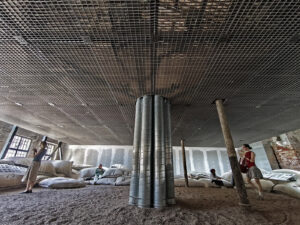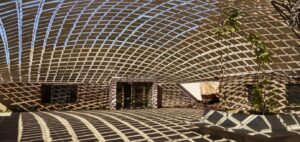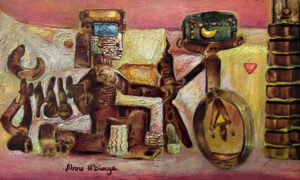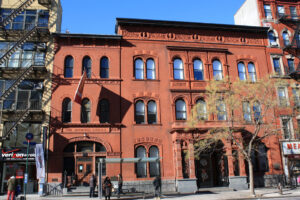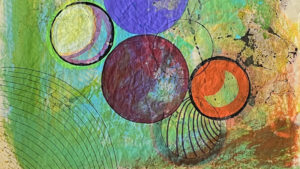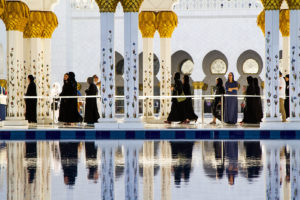Many interventions are rooted in the city, and so there is no getting away from trying to understand the urban environment, the history behind how the existing buildings have evolved and how the city sprawled its way from the waterside towards the mainland. In the UAE, architecture and design are two fields that have received prominent attention, with a focus on designing energy-efficient, sustainable buildings that reduce carbon emissions and promote the use of renewable energy sources.
Rana Asfour
The most often quoted definition for sustainability comes from the UN World Commission on Environment and Development: “sustainable development is development that meets the needs of the present without compromising the ability of future generations to meet their own needs.”
Sustainability presumes that resources are finite and should be used conservatively and wisely, with a view to long-term priorities and consequences of the ways in which resources are deployed. Therefore sustainable practices are those which support long-term health and vitality on the ecological, human, and economic levels. In the simplest terms, sustainability is about our children and our grandchildren, and the world they will inherit.
Figures show that in 1960, Dubai had 40,000 residents, a population that has now risen to just over 3.3 million, a time of exponential growth during which the city has implemented seven versions of its Urban Master Plan. The latest version, “Dubai 2040,” encourages use of mass transit, walking and cycling, doubles the land allotted to green and recreational spaces, and preserves 60% of the total area of the Emirate as nature reserves. Thanks to increased wealth, desalination has partly greened the urban landscape, and air conditioning has not only changed the lives of those who live in the country but has invited year-round tourism.
Ask any Emirati and they will argue that sustainability in the UAE has always been a way of life, whether through the design of the urban alleyways and walkways, compacted walls of the houses, or through the smaller courtyards, always well-shaded, where family members usually gather. This has meant that, over the years, urban architecture seemed to organically organize itself and adapt in ways that allowed people to live in harmony with an environment characterized by mild, warm winters and excruciatingly hot summers, where high temperatures and oppressive humidity build for months, unrelieved by rain.
Though the UAE is on the verge of its 52nd birthday, “It wasn’t long ago that the camel was not only a means of transportation, but a source of hide, milk, and on very rare and special occasions, meat,” said Hareth Al Bustani, an Emirati-Briton and the Arts & Culture Editor at The National newspaper. “And from the date palm, people harvested not only the fruit, but also the materials for building, and for crafts. Emirati homes, up until not too long ago, were traditionally built around the climate through the use of the Barjeel Windtowers in the courtyards, which are designed to funnel the cool air through the buildings.” These remarks were given during the opening session of a recent one-day conference held in Abu Dhabi, under the title “Science for Sustainability” — only one of a multitude of conversations taking place within the UAE, as the country counts down to the final weeks before its landmark date on November 30th, when world leaders will come together for COP28, with a view to uniting the world on bold, practical and ambitious solutions to the pressing problem of global climate change.
Architecture and design are two fields that have received prominent attention, with a focus on designing energy-efficient, sustainable buildings that reduce carbon emissions and promote the use of renewable energy sources.
“When we talk about sustainable architecture, we are not just limited to the environment, although it is a huge consideration given the UAE is situated in one of the world’s harshest climates,” says Farid Esmaeil, founding partner and principal architect of X Architects, a leading architecture and urban design practice in Dubai, known for translating Arabic and Islamic culture into contemporary designs with sustainable solutions. Part of a panel at the same conference, Esmaeil discussed the layers to consider before any architectural structures can be built, like culture, heritage, the social life around a building, and lastly, the economy. “Once we’re sure these criteria have been met,” he said, “the direction nowadays is towards constructing buildings that are contextual, adaptive, and responsive. We want to bring in modernity and be progressive and to build within today’s latest technologies, but at the same time we want to learn from our heritage and make sure that what we’re designing ensures a balance between past and present.”
Culture and cultural heritage can help to achieve inclusive and sustainable development; yet preserving rich cultural heritage while striving for a sustainable future presents a unique set of challenges for heritage sites. “We need to pause and reflect on what has been built so far, and question how we can make sure that before whatever building we plan from now on, we’ve made sure to exhaust every alternative before we transform land into a new piece of building,’ said Lina Ahmed, Associate Professor and Chair of Design at Zayed University, speaking on a panel in Abu Dhabi titled “Sustainable Education in an Urban World.”
In rapidly developing urban environments like the UAE, sustainability seems to take on a different urgency, requiring educators and urban planners to come up with unique tailor-made safeguards and measures to define a new contemporary Emirati sustainable community. As a new urban habitat that comes coupled with a new urban lifestyle in which social and technological change is almost constant, the standards of traditional pre-industrialization urban development, when speed and scale were not so paramount, now appear obsolete. This means that the transformation of UAE cities to Net Zero cities specifically, at a time where the populations of the cities are continuously increasing, and climate change is worsening — even as you read these words — will have to be approached in a manner that is different to any societal change that has ever been done before.
Globally speaking, there has been a fundamental change to the energy infrastructure of civilization: both where the world gets the energy from, and how it will be used. And it’s a switch that’s proving to be expensive — in 2021 Dubai announced a net zero investment of Dh600 billion (US$160 billion) in clean and renewable energy sources to be spent over the next three decades. “The transformation will be a technological, economic and social one … And yet, [despite all the challenges], we are also saying that the Net Zero transformation is too urgent to wait for a gradual, emergent transition; we cannot wait for it to develop at its own pace,” writes Farah Naz, Regional Head of Innovation in ESP for the Middle East and Africa, AECOM in her most recent publication Net Zero City: The Ten Year Transformation Plan: How to Overcome the Climate Crisis by 2032 (Langdon Morris, 2021).
“While many have resisted the need to abandon fossil fuels since to them it means sacrifice,” adds Farah Naz, “in fact the necessity to innovate on this scale, across the entirety of human society, is a very gift … the climate emergency actually offers us the chance to remake critical aspects of our society to be much better than they ever were during the fossil fuel era.
“And this transformation will be led by our cities. Cities are the unique milieu where civilization was created, and today they are the innovation catalysts where the transition to a new and sustainable society will emerge to change the world… so perhaps it is our ability to innovate that will largely determine our fate. Innovate well and we can survive and thrive; fail to innovate and we are doomed to prolonged suffering and decline.”
According to Naz, current trends suggest that by 2100 about 95% of the total human population of perhaps 8 billion will be living in some sort of urban setting. And so, “we must design and engineer this transition, and make it happen on a time scale that is exceptionally fast,” she insists. “First, we need an urban system framework that enables us to understand and manage the broad complexity of the Net Zero Transformation challenge; we need a general Theory of Social Change to guide us through the very challenging process of changing ourselves, the city and civilization; we require a new definition of Action Practices and Examples that show us what we need to do, and finally a Transformation Roadmap that shows us how to proceed, step by step.”
Change can be frightening and rapid change even more so. But change is inevitable. Therefore, engaging with the public in thinking about the future and co-creating the community that people want to live in has proven to be a very effective change management strategy.
“An excellent example of this sort of public engagement is the Dubai Museum of the Future,” writes Naz. The museum, which opened its doors in 2022, boasts a goal of inspiring and empowering people to positively shape humanity’s next chapter. It “takes a proactive stance toward understanding what the future may hold, and thereby becomes a significant resource for the UAE, as well as the broader global community,” Naz argues.

Sharjah Architectural Triennial: The Beauty of Impermanence
The Sharjah Architectural Foundation was founded in 2018, and intended to be a regional platform for architecture and urbanism, with the decision made to extend its reach into West Asia, South Asia and the African continent because of these geographies’ historical commercial and cultural exchanges with the UAE.
“The interest was to invite cultural conversation between multiple stakeholders because we believed that the concept of architecture should be broadened beyond a concept of building to include the professional bodies, academia and the general public, in order to create a conversation around urbanism and architecture with regards to their social implications,” said Mona El Mousfy, the Architecture Consultant for the Sharjah Art Foundation since 2005, on a call with TMR. “In our programming we focus on international topics that have a local resonance, or local and regional investigations and experiences that can have a real pertinence to current local debates on architecture. This is particularly evident in the upcoming second edition of the Sharjah Architectural Triennial in November in which the relationship between social and environmental sustainability has never been more intimately related.”
“The Beauty of Impermanence: An Architecture of Adaptability,” which runs from November 11, 2023 to March 10, 2024 is curated by Tosin Oshinowo, a Lagos-based Nigerian architect and designer, creative entrepreneur, public speaker and founder of cmDesign Atelier. The exhibition’s theme refers to how issues of scarcity in the Global South have created a culture of re-use, re-appropriation, innovation, collaboration and adaptation.
Renowned for her expansive residential and commercial spaces and insights into socially-responsive approaches to urbanism, Oshinowo views this edition of the Triennial as a continuation from where curator Adrian Lahoud’s first edition left off three years ago in which he was committed to “radically rethinking fundamental questions about architecture and its effect on the climate, whereby the existence of a North/South divide has directly influenced the challenges and exacerbated the situation we find ourselves in climatically,” said Oshinowo.
To enrich her curatorial vision for 2023, Oshinowo insisted on putting together a curatorial advisory board of international architects, artists and designers, headed by Hoor Al Qasimi, President of Sharjah Architecture Triennial and President & Director of Sharjah Art Foundation. “The Beauty of Impermanence and Architecture of Adaptability” predominantly looks at those design and building innovations brought about by conditions of scarcity that tend to still exist within the Global South. It is a type of architecture that utilizes lessons learned from previous traditions and ways of doing things.
“The reason this is important as a phenomenon, is because if you look at several countries within the global south, working within limitations, whether out of choice or not, the austere circumstances certainly appear to have allowed people in these locations to become more innovative, and I find this a very interesting point,” says Oshinowo
“In pre-industrialization days, building shelter was more in tune with the surrounding ecology, and yet we find that despite the convenience we enjoy thanks to progress and modernity, there’s been a massive compromise. When we start to look at some of the solutions on show at the Triennial, especially those coming from locations that have always had to work with limitations, they tend to be in better balance with the environment. Seeing all this helps us to question what really has been the cost of what we consider as modernism and prosperity and the convenience it has afforded us, from air conditioning to plastic to uber clinical surfaces that are so far-removed from how we used to live pre-industry when we were in better balance with the environment. When we think of the reality of austerity and planetary scarcity because of how we’ve taken an unhealthy run at our resources, it should force us to consider the lessons that we can learn from some of the solutions on exhibit that have so eloquently created balance within an ecology of scarcity.
“We are dealing with a world now where we are all, ironically, dealing with some level of austerity — especially exacerbated by wars and Covid — in which a pause becomes necessary to reflect and think about how we can approach things differently, and what lessons we can learn from this region that has been conditioned to believe that the solution to its problems can only come from the North. Rarely has there been a conscious study undertaken to understand all these places that are still able to exist in modernity despite being seemingly stuck in pre-industrialization conditions. The purpose of the Triennial is to find solutions that offer a balance between modernity and tradition in an optimistic and hopeful way.”
As the 31 artists began sending in their works, Oshinowo noticed three emerging strands that approached the concept of developing the urban environment. All solutions on exhibit aim to shift global conversations towards creating a more sustainable, resilient, and equitable future.
“The first strand was contextual, which is looking at practices that were balancing this idea of tradition with modernity in an eloquent way that strove to reduce the negative impacts of modernity. These participants tend to work within the environment contextually, while also considering opportunities for upcycling and recycling. The second strand we came across was extraction politics, which are practices consciously aware of the tensions between the economics of city development and balancing that with the surrounding ecology. The third strand centered on intangible bodies, in which practitioners are very much about the ephemeral: empathy, soulfulness and humanity.”
The exhibition is designed around the exploration of space, materials, social sustainability and the importance of putting people at the center of the built environment with equal regard to the ecology.
“I am very excited for people to see the urban bird nest by MOE+ Art Architecture (MOE+AA) (Nigeria) installed in the industrial area of Sharjah, designed as a pavilion to encourage wildlife to consider it a home. Another installation will be housed in Sharjah’s former slaughterhouse, a building the foundation is using as an adaptive re-use for the exhibition in which these artists bring to the fore the idea of consumption in relation to ecology and again question the balance that we’ve veered off from. Sumaya Dabbagh, from Saudi Arabia, will examine the relationship between memory and materiality through an installation made from mud, celebrating the universal qualities of a material that conveys the cycle of life and death, growth and decay and Natura Futura (Ecuador) will present community-based design solutions, showcasing a floating housing community project in Babahoyo River that was built during the planning and production of the Triennial.” Additionally, Adrian Pepe, a fiber artist, will study the beginnings and evolution of shelter by contrasting modernity and tradition, providing insights into the historical and present narratives that emerge when industrial capitalism and nomadic independence are combined. To coincide with the opening, a new publication entitled Field Notes: On Scarcity will be launched reflecting on the various concepts explored and presented within the Triennial.
Examining the history of a city’s existence, and trying to understand the role that the economics and politics of location have played in its evolution helps to explain why some things are the way they are. Many interventions are rooted in the city, and so there is no getting away from trying to understand the urban environment, the history behind how the existing buildings have evolved and how the city sprawled its way from the waterside towards the mainland. It is also crucial to consider the relationship between the different communities that exist within a certain space.
“When I first came to Sharjah, I was fascinated by this idea of civic status,” said Oshinowo. “So much about generational wealth is about leaving things for children, planning and structuring and being rooted to something. I find there is too much emphasis on having a permanent civic status and having groundings in a location, but the irony is that we don’t take any of it with us when we die. I think that, sadly, our modern world is too heavily invested in permanence. If we acknowledge that we are not here forever, I think we would be more respectful of our open environment and our landscape as a whole. There is something really beautiful about not trying to hold onto things much. And if we take this as a reality and a mindset, how beautifully balanced things could really be!”
Further Reading:
Windtower: The Merchant Houses of Dubai by Peter Jackson and Anne Coles, Medina Publishing, 2023. Windtower offers a unique insight into a past way of life, and the culture and history of the city of Dubai. This new and extended edition celebrates the 50th anniversary of the formation of the United Arab Emirates, providing more information on the role played by the merchant community and its contributions to Dubai’s success in trade and commerce. It also considers the lessons that might be learned from Dubai’s windtowers and traditional built forms, at a time of global warming and climate crisis, and how these lessons might benefit contemporary urban design.
Net Zero City: How to Overcome the Climate Crisis by 2032 by Langdon Morris and Farah Naz, Langdon Morris, 2023. This book provides a detailed analysis of the steps necessary for any city to attain Net Zero.












